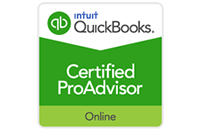A cash flow forecast is arguably the most important business tool for every business. It will tell you if your business will have enough cash to run the business as is, or enough to meet your expansion goals. It will also let you know when more cash is going out of the business than is coming into it. (Not good!)
There are many cash flow forecasting worksheets online, but the process is similar for all of them. Here’s what you need to do. The easiest way to prepare a cash flow forecast is to break the task into the five steps shown below.
Sales Forecast Steps
Calculate the income or sales for your business
If you have an existing business take a look at last year’s sales figures. Then decide what adjustments to make based on past trends or coming changes. Are sales increasing, decreasing, or staying the same? Are there upcoming regulatory changes coming?
If your business is new, when you prepare your cash flow forecasts, you might want to start by first estimating all your cash outflows. Doing this will give you an idea of how much cash you need to have coming to cover the cash going out. Thus, you’ll know what sales you’ll need to make to cover your expenses.
Of course, your sales figures are always changing because of variable factors like the types of customers you sell to, how quickly they have to pay you, what the economy is doing (globally and locally), and what your competitors are doing, not to mention any inventory or infrastructure issues.
Detail any other estimated cash inflows
These ‘cash inflows’ will vary from business to business, but may include:
• tax refunds
• additional equity invested in the business
• government or other grants
• loans are paid back to you or you sell an asset
• other sources such as royalties, franchise fees, or license fees.
Calculate all estimated cash outflows and expenses
When analyzing your cash outflows, work out what it costs to make your goods available. Doing this will make it easier to adjust actual cost of goods sold. For example, if you forecast you would sell 5 pieces of equipment but actually sold 10, it will be easier to up your cost of goods sold.
Expenses are also money spent on administration and operating costs. Again, they will vary depending on the type of business you are starting or already run.
Other cash outflows
Beyond normal operating expenses, cash also leaves a business in other ways. Examples are:
• buying new assets
• ‘one off’ bank fees (i.e. loan establishment fees)
• loan repayments
• payments to owner(s)
• investing of surplus funds.
Prepare your cash flow forecast using all the gathered numbers
Decide what period you want your cash flow to cover. Typically, this is done annually with monthly or quarterly inflows and outflows. Since cash flows are all about timing and the flow of cash, you will need start with an opening bank balance (actual cash on hand), then add in all the cash inflows and deduct the cash outflows for each period. The number at the end of each period is referred to as the closing cash balance and this number becomes the opening cash balance for the next period
Remember that cash flow is all about timing and the flow of cash, so when preparing your cash flow forecast, make sure you are as accurate as possible on the timing of the cash flows, both in and out.
Review your estimated cash flows to actual
Here is the most important step. Once you’ve created your cash flow forecast, make sure you go back and check what you estimated against the actual cash flows for the period. You’ll do this to highlight any differences between your estimated and actual figures, and it will help you see why your cash flow didn’t meet your expectations, if that’s the case.
Cash flow forecasts can help predict upcoming cash surpluses or shortages to help you make better business decisions. They can help in tax preparation, planning new equipment purchases or identifying if you need to secure a small business loan. You can also use a cash flow forecast to see the effect of an upcoming business change or decision. If you’re considering hiring a new employee for example, you’d add the additional salary and related costs into your forecast. The new figures in your cash flow forecast will tell you whether hiring that additional employee is likely to place your business in a stronger position and help you decide whether to hire them or not.
ENSO Accounting is an independent accounting firm positioned to respond to clients’ exacting expectations with clarity, transparency, and professional support. ENSO Accounting financial data can simply many business decisions with expert forecasting and analysis assistance. We’re here to help your business. Call us today!
ENSO ACCOUNTING
643 Liberty Road, Suite 101
Eldersburg, Maryland 21784
443-920-3451
info@ENSOaccounting.com



